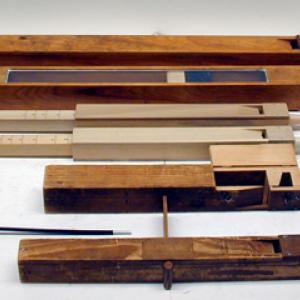College of Liberal Arts & Sciences
3D32.25 - Organ Pipes and Whistles
See Also: Galton's Whistle 3C20.15.
Fill one of the organ pipes with helium and observe how the pitch changes. The change in pitch is due to the fact that the resonant frequencies of the organ pipe depend on the speed of sound in the gas in it. The speed of sound is greater in helium than in air, therefore the organ pipe will have a higher pitch.
When breathing helium your vocal tract acts as a filter for the sounds produced by the vocal folds. In effect, the higher frequencies are enhanced and the intensity of the lower frequencies is lessened.
The police whistles and the variety of other whistles show the resonance of a single cavity.
- Thomas B. Greenslade Jr., "Whistling Tea Kettles, Train Whistles, and Organ Pipes", TPT, Vol. 54, #9, Dec. 2016, p. 519.
- Jay S. Huebner, N. Sundaralingam, "Simple Sound Demonstrations", TPT, Vol. 36, # 1, p. 16, Jan. 1998.
- Thomas B. Greenslade, Jr., "The Acoustical Apparatus of Rudolph Koenig", TPT, Vol. 30, # 9, Dec. 1992, p. 518.
- Brian Holmes, "The Helium - Filled Organ Pipe", TPT, Vol. 27, # 3, p. 218, March 1989.
- Kevin W. Tibbs, et al., "Letters: Helium High Pitch", TPT, Vol. 27, # 4, p. 230, April 1989.
- Thomas B. Greenslade, Jr., "Nodes and Antinodes in Organ Pipes", TPT, Vol. 19, # 3, Mar. 1981, p. 186.
- Thomas B. Greenslade, Jr., "Triangular Organ Pipe", AJP, Vol. 89, #3, March 2021, p. 276.
- Thomas B. Greenslade, Jr., "Organ Pipes (Photo)", AJP, Vol. 72, # 8, Aug. 2004, p. 1034.
- Se- 9: Freier and Anderson, A Demonstration Handbook for Physics.
- W- 215: "Organ Pipes", DICK and RAE Physics Demo Notebook.
- W- 360: "Whistles", DICK and RAE Physics Demo Notebook.
- Rev. J. Lukin, "Our First Organ", The Boy Engineers, p. 135.
- John Henry Pepper, "Vibrations of Columns of Air", Cyclopadic Science Simplified, p. 511.
- H. Richard Crane, "How Physics Is Used to Repel Deer and Fleas", How Thing Work ( 1983 - 1995 ), p. 49.
- Neville Fletcher, Suszanne Thwaits, "The Physics of Organ Pipes", Musical Acoustics, p. 189.
- Jearl Walker, "3.3, Whistles and Whistling", The Flying Circus of Physics Ed. 2, p. 147.
- 1.58, Jearl Walker, "Police Whistle", The Flying Circus of Physics with Answers.
- "151, Helium Speech", Christopher P. Jargodzki and Franklin Potter, Mad About Physics, p. 57, 200.
- Simon Topman, "How To Be Good At What You Do - A Whistle's", Popular Mechanics, Nov./Dec. 2020, p. 88.
- Joseph Frick, "#140 - The Theory of the Organ Pipe", Physical Technics: Or, Practical Instructions for Making Experiments in Physics and the Construction of Physical Apparatus with the Most Limited Means", p. 166.
- Woodstock Percusion, Inc, "The American Slide Whistle manual", Shokan, NY 12481.
Disclaimer: These demonstrations are provided only for illustrative use by persons affiliated with The University of Iowa and only under the direction of a trained instructor or physicist. The University of Iowa is not responsible for demonstrations performed by those using their own equipment or who choose to use this reference material for their own purpose. The demonstrations included here are within the public domain and can be found in materials contained in libraries, bookstores, and through electronic sources. Performing all or any portion of any of these demonstrations, with or without revisions not depicted here entails inherent risks. These risks include, without limitation, bodily injury (and possibly death), including risks to health that may be temporary or permanent and that may exacerbate a pre-existing medical condition; and property loss or damage. Anyone performing any part of these demonstrations, even with revisions, knowingly and voluntarily assumes all risks associated with them.
